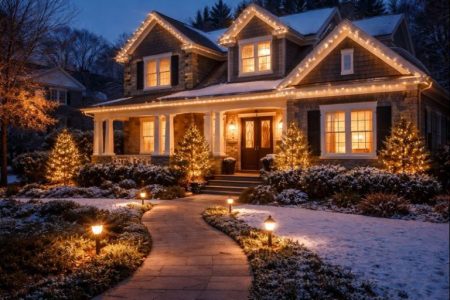Why the Roof Matters More Than You Think
Let’s be honest—when was the last time you really thought about your roof? Unless it’s leaking, probably never. But here’s the thing: that humble roof over your head might be the silent reason your energy bill is through the roof (pun intended) or why there’s a weird smell in your guest room.
If you’re dealing with mysterious ceiling stains, rising energy bills, or a sudden invasion of pests—your roof might be the hidden culprit. And if you haven’t considered roof cleaning in Lake Ridge as part of your home maintenance routine, now’s the time.
A Silent Culprit Behind Everyday Annoyances
You might blame your air conditioning, your drywall, or even your plumbing. But quite often, the real villain is hiding in plain sight—your roof. Let’s dive into the most common home complaints that are often linked to roof neglect.
Water Woes: Leaks, Stains & Mold
The Water Stain Mystery on Your Ceiling
You see a yellowish stain on the ceiling and assume it’s a one-time spill or some harmless humidity. In most cases, it’s a leaking roof letting in water during rainstorms.
Mold in Unexpected Places
That mold patch in the closet or behind furniture? It’s not just poor ventilation. Water from a damaged roof seeps into walls, making them breeding grounds for mold.
Damage to Interior Paint and Drywall
If your paint is bubbling or drywall is crumbling, the source might be above you. Roof leaks trickle down and destroy interior finishes quietly over time.
Rising Energy Bills
Poor Roof Insulation = High HVAC Costs
Ever feel like your heating or cooling system is working overtime? It probably is—because your roof is failing to insulate properly.
Heat Escaping Through the Attic
During winter, heat rises—and escapes through poorly maintained roofing. You’re basically paying to warm the sky.
How a Damaged Roof Affects Energy Efficiency
Cracks, missing shingles, and deteriorated underlayment allow outside temperatures to sneak in, throwing your thermostat into chaos.
Unwanted Guests: Pests and Critters
Rodents Nesting in the Attic
A small roof opening is a welcome sign for rats and squirrels. Once inside, they chew wires, insulation, and wood.
Insects Invading Through Roof Gaps
Bees, termites, and ants can enter your home through roof cracks. By the time you notice them, they’re already settled.
Structural Damage and Sagging Ceilings
Compromised Roof Decking
A neglected roof allows water to warp the decking underneath, causing dips and weak spots in your ceiling.
How Moisture Weakens Support Beams
Water damage rots wood and weakens support beams—making your home unsafe over time.
Decreased Curb Appeal
Visible Damage and Missing Shingles
From the street, missing shingles or sagging areas tell buyers and neighbors one thing: this home has been neglected.
Impact on Home Value
Real estate experts agree—a bad roof knocks down your home’s market value faster than nearly any other exterior issue.
Gutter Troubles That Start at the Roof
Overflowing Gutters and Ice Dams
Clogged gutters often stem from poor roof drainage. Water backs up, freezes in winter, and damages the roof and fascia.
Foundation Issues from Poor Drainage
Roof water that isn’t directed properly can erode the foundation, causing cracks and basement flooding.
Interior Humidity and Comfort Imbalance
Why Some Rooms Feel Colder or Hotter
An inconsistent indoor climate often links back to poor roof ventilation or insulation gaps.
How a Leaky Roof Triggers Indoor Climate Issues
Leaks can lead to trapped moisture, which creates that sticky, humid feeling inside your home.
Roof Neglect and Health Concerns
Respiratory Issues from Mold
Mold spores from roof leaks can trigger asthma, allergies, and other respiratory conditions—especially in kids and the elderly.
Allergies Triggered by Moist Environments
Dampness from roof leaks is a haven for allergens like dust mites and mold—leading to year-round sniffles and sneezes.
Cracks in Walls and Ceilings
How Roof Leaks Affect Structural Alignment
When water saturates internal structures, they shift or crack under pressure, causing gaps and fissures.
When You Need More Than a Paint Job
Covering up a ceiling crack with paint won’t stop it from growing if the real cause is above your head.
Roof Lifespan and Warranty Woes
Voiding Your Roof Warranty Through Neglect
Most warranties require regular maintenance. Ignoring your roof? You may be voiding your coverage without knowing it.
The Cost of Avoiding Regular Inspections
Skipping inspections means small problems turn into big-ticket repairs—costing thousands more than preventative care.
Storm Damage That Goes Unnoticed
Wind-Lifted Shingles
Strong winds can lift and curl shingles. If you don’t spot it quickly, water seeps underneath and starts rotting the deck.
Small Hail Cracks That Lead to Big Leaks
Hail can cause micro-cracks that grow with time. They’re not always visible from the ground, but they’re dangerous.
Noise Issues: Creaks, Cracks, and Drafts
Why Your House is Noisier Than It Used to Be
A compromised roof lets in sound. That creaking? It might be roof beams shifting from water damage.
Wind Whistling Through Gaps
When the wind howls like a ghost, it’s usually air passing through holes in your roof you didn’t even know existed.
Real Estate Headaches
Roof Issues During Home Inspections
Selling your home? A bad roof will scare off buyers or invite lowball offers.
How Roof Neglect Delays Sales
Buyers want turnkey homes. A roof that needs work is a red flag—and often a deal breaker.
What Regular Roof Maintenance Looks Like
Annual Inspections
A once-a-year professional roof check-up can save you thousands down the road.
Gutter Cleaning and Debris Removal
Blocked gutters can cause water to back up onto the roof. Clean them at least twice a year.
Minor Repairs Before They Grow
Fixing a few shingles now prevents major leaks and structural repairs later.
Signs Your Roof is the Root Problem
Checklists for Homeowners
Keep an eye out for:
- Curling shingles
- Interior water stains
- Sudden pest infestations
- Higher energy bills
When to Call a Roofing Professional
If you’re unsure, it’s better to call in an expert than risk major damage from delayed action.
Cost of Roof Neglect vs. Maintenance
Short-Term Savings, Long-Term Expenses
You might save a few bucks today skipping maintenance, but a full roof replacement costs $7,000–$15,000.
Maintenance as an Investment
Think of maintenance as home insurance: a small price now to avoid a financial disaster later.
Prevention is Protection
Why You Should Act Before Problems Arise
By the time you see the problem, it’s probably too late. Roof issues are sneaky like that.
Simple Habits to Preserve Your Roof
- Trim tree branches
- Remove debris after storms
- Schedule annual inspections
Conclusion
Don’t Wait Until It’s Too Late
Your roof is your home’s first line of defense—and its most overlooked asset. Stop blaming your HVAC, pest control, or painter. The root of many household headaches lies above your head. So next time you spot a small leak, don’t ignore it. Show your roof some love, and your whole house will thank you for it.
FAQs
1. How often should I inspect my roof?
You should inspect your roof at least once a year, preferably in the spring or fall. After a major storm, a quick visual check is also wise.
2. What are early signs of roof damage?
Look for missing or curling shingles, water stains on ceilings, granules in gutters, and sagging spots on the roofline.
3. Can roof damage affect home insurance?
Yes, if your insurance company finds that neglect led to the damage, they may deny your claim.
4. Is roof maintenance tax-deductible?
For homeowners, it typically isn’t. But for rental properties, maintenance can often be deducted as an expense.
5. How much does regular roof maintenance cost?
Basic maintenance (cleaning, inspection, small repairs) usually costs between $150–$500 per year—far cheaper than major repairs or replacements.






